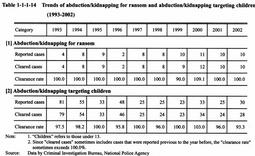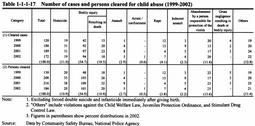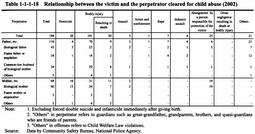| Previous Next Index Image Index Year Selection | |
|
|
4 Trends in noteworthy penal code offenses This subsection reviews the trends of penal code offenses that usually attract attention from the public.
(1) Offenses related to homicide Table 1-1-1-12 shows the number of cleared cases for homicide for insurance money over the last 10 years. The number has increased since 1998.
Table 1-1-1-12 Number of cleared cases for homicide for insurance money (1993-2002) Table 1-1-1-13 shows the trends in the number of reported and cleared cases for random killings (killing or causing bodily injuries to unspecified people at random without clear motivation, at a place accessible to anyone often with the use of weapon) over the last 10 years.Table 1-1-1-13 Number of reported cases and number of cleared cases for random killings (1993-2002) (2) Offenses related to abduction/kidnapping Table 1-1-1-14 shows the trends in the number of reported and cleared cases, and clearance rate for malicious abduction/kidnapping cases, i.e. those for ransom and those targeting children under 13 years of age, over the last 10 years.
The reported cases for abduction/kidnapping for ransom were less than 10 until 1998, but they have been 10 or more since 1999. The clearance rate has remained at a high level both for adduction/kidnapping for ransom and adduction/kidnapping targeting children. Table 1-1-1-14 Trends of abduction/kidnapping for ransom and abduction/kidnapping targeting children (1993-2002) (3) Offenses related to robbery Table 1-1-1-15 shows the trends in the number of reported and cleared cases, and clearance rate for robbery targeting cash transit vehicles, financial institutions, and overnight supermarkets, over the last 10 years. The reported cases for robbery targeting cash transit vehicles have been on a par at around 10, without significant fluctuation except in 1997. The reported cases of robbery targeting overnight supermarkets have been over 300 since 1998, considerably more than those in the previous period.
The salient feature of 2002 was that the decline in the clearance rate stopped for robbery in general, and the clearance rate for these peculiar types of robberies also improved significantly compared with the previous year. Table 1-1-1-15 Trends of robbery targeting cash transit vehicles, financial institutions, and overnight supermarkets (1993-2002) (4) Card crimes Table 1-1-1-16 shows the trends in the number of reported and cleared cases, and clearance rate for card crimes committed by misusing credit cards, cash cards, and consumer loan cards, etc., over the last 10 years
When we look at the 3,521 cases cleared for card crimes in 2002 by type of card, 1,946 cases (55.3%) involved cards that were stolen or found on the street, etc., 769 cases (21.8%) involved counterfeit cards, and 806 cases (22.9%) involved other cards. The number of cases in which counterfeit cards were used increased by 191 from the previous year (Source: Data by Criminal Investigation Bureau, National Police Agency). A common modus operandi for committing card crimes is to illegally obtain or "skim" electromagnetic data contained in cards with the use of electronic devices, and then to misuse counterfeit cards made by using such data. In light of this, an offense relating to electromagnetic records in payment cards was newly established upon the partial amendment to the Penal Code in June 2001 (entry into force in July 2001). This amendment was intended to impose heavier punishments for illegal production/use of electromagnetic records in payment cards and deposit/savings withdrawal cards, and also to include the acts of assigning, lending, importing, or possessing a card containing illegally produced electromagnetic records as well as the act of illegally obtaining electromagnetic information contained in cards, in the scope of punishable acts. In 2002, 287 cases were reported, 277 cases were cleared, and 148 persons were cleared for offenses involving electromagnetic records in payment cards (Source: Criminal Statistics by National Police Agency). Attention should be paid to the future trend of this type of offense. Table 1-1-1-16 Number of reported cases, number of cleared cases, and clearance rate for card crimes (1993-2002) (5) Child abuse The Law Concerning the Prevention of Child Abuse (Law No. 82 of 2000) was established in May 2000 and entered into force in November 2000. Though not having the special provisions on punishments for crimes related to child abuse, the Law clearly mentioned that no person shall be permitted to abuse a child and a person who commits such an offense should not be immune from being punished on the ground that he/she is the person having parental power.
Table 1-1-1-17 shows the trends in the number of cases and persons cleared for child abuse, by type of offense; 172 cases and 184 persons were cleared in 2002. Table 1-1-1-18 shows the breakdown of 184 persons cleared for child abuse in 2002, by the relationship between the perpetrator and the victim. Among all the persons cleared, 116 persons were fathers etc., accounting for more than 60% of the total. On the other hand, among those cleared for offenses that directly threaten a child's life and safety, e.g. homicide, bodily injury resulting in death, and abandonment by a person responsible for protection of the victim, mothers accounted for a larger share than fathers, and biological mothers accounted for a larger share than biological fathers. Table 1-1-1-17 Number of cases and persons cleared for child abuse (1999-2002) Table 1-1-1-18 Relationship between the victim and the perpetrator cleared for child abuse (2002) (6) Organized crimes Under the Law For Punishment of Organized Crime, Control of Crime Proceeds and Other Matters, a person who commits specific penal code offenses such as homicide shall be subject to an augmented punishment in the case where (i) the offense is committed as a group activity by an organization that is intended for such activity or (ii) the offense is committed for the purpose of enabling the group to obtain illegal interests. The Law also punishes acts of money laundering, such as disguising or concealing crime proceeds, under certain conditions, and stipulates procedures for depriving offenders of crime proceeds. The Law entered into force in February 2000. Table 1-1-1-19 shows the trends in the number of persons newly received by public prosecutors offices for violation of the law.
Table 1-1-1-19 Number of persons newly received by public prosecutors offices for offenses related to the Law For Punishment of Organized Crime, Control of Crime Proceeds and Other Matters (2000-2002) Explanation of termsPenal code offense: Penal code offenses include (1) offenses prescribed by the Penal Code and (2) offenses that are prescribed by other laws but have common characteristics with those prescribed by the Penal Code. For instance, the Law Concerning the Prevention and Punishment of Burglary, Robbery, Larceny, etc. imposes a heavier punishment for larceny that satisfies certain requirements as habitual recidivist larceny, which shares characteristics with larceny under the Penal Code and therefore is included in the category of penal code offense. For the precise scope of penal code offenses, see NOTES. Special law offense: Special law offenses refer to offenses other than penal code offenses, such as violation of the Road Traffic Law and violation of the Stimulant Control Law. General penal code offense: General penal code offenses refer to penal code offenses excluding professional negligence in traffic accidents. Professional negligence in traffic accident: A person who by negligence has killed or injured another in a traffic accident shall be charged for professional negligence resulting in death or bodily injury or gross negligence resulting in death or bodily injury under Article 211 of the Penal Code. The offense in such case is referred to as professional negligence in traffic accidents. As professional negligence in traffic accidents is committed by negligence and its influence on public security is different from that of homicide and larceny, the White Paper on Crime deals with professional negligence in traffic accidents separately from general penal code offenses in the category of penal code offenses for analysis, if necessary. Unsafe driving resulting in death or injury (Article 208-2 of the Penal Code), which was newly established upon the legal amendment in 2001, is included in general penal code offenses rather than professional negligence in traffic accidents. For the precise scope of professional negligence in traffic accidents, see NOTES. Number of reported cases: The number of cases that are reported to the police or other investigation authorities. Crime rate: The number of reported cases per 100,000 persons. Number of cleared cases: The number of cases that are cleared by the police or other investigation authorities, including cases that are referred to public prosecutors offices or disposed as minor offenses. Clearance rate: The percentage of the number of cleared cases in the number of reported cases. Number of persons cleared: The number of suspects who are cleared by the police etc. |








